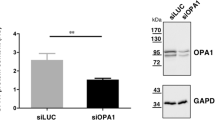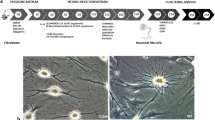Abstract
Anomalous choline metabolic patterns have been consistently observed in vivo using Magnetic Resonance Spectroscopy (MRS) analysis of patients with neurodegenerative diseases and tissues from cancer patient. It remains unclear; however, what signaling events may have triggered these choline metabolic aberrancies. This study investigates how changes in choline and phospholipid metabolism are regulated by distinct changes in the mitochondrial electron transport system (ETS). We used specific inhibitors to down regulate the function of individual protein complexes in the ETS of SH-SY5Y neuroblastoma cells. Interestingly, we found that dramatic elevation in the levels of phosphatidylcholine metabolites could be induced by the inhibition of individual ETS complexes, similar to in vivo observations. Such interferences produced divergent metabolic patterns, which were distinguishable via principal component analysis of the cellular metabolomes. Functional impairments in ETS components have been reported in several central nervous system (CNS) diseases, including Alzheimer’s disease (AD) and Parkinson’s disease (PD); however, it remains largely unknown how the suppression of individual ETS complex function could lead to specific dysfunction in different cell types, resulting in distinct disease phenotypes. Our results suggest that the inhibition of each of the five ETS complexes might differentially regulate phospholipase activities within choline metabolic pathways in neuronal cells, which could contribute to the overall understanding of mitochondrial diseases.




Similar content being viewed by others
Abbreviations
- AA:
-
Arachidonic acid
- AD:
-
Alzheimer’s disease
- ANOVA:
-
Analysis of variance
- CDP-Cho:
-
Cytidine diphosphate choline
- Cho:
-
Choline
- CNS:
-
Central nervous system
- ETS:
-
Electron transport system
- GPC:
-
Glycerophosphorylcholine
- GPC-PDE:
-
Glycerophosphorylcholine phosphodiesterase
- HD:
-
Huntington’s disease
- MPTP:
-
1-Methyl-4-phenyl-1,2,3,6-tetrahydropyridine
- HIF-1α:
-
Hypoxia-inducible factor-1α
- Htt:
-
Huntington gene
- MALDI-TOF:
-
Matrix-assisted laser desorption/ionization
- MS:
-
Mass spectrometry
- NAA:
-
Non-essential amino acids
- NMR:
-
Nuclear magnetic resonance spectroscopy
- 3-NP:
-
3-Nitropropionic acid
- PCA:
-
Principal component analysis
- PC:
-
Phosphorylcholine
- PD:
-
Parkinson’s disease
- PLA2 :
-
Phospholipase A2
- PLC:
-
Phospholipase C
- PLD:
-
Phospholipase D
- PtdCho:
-
Phosphatidylcholine
- ROS:
-
Reactive oxygen species
- Tau:
-
Taurine
- tCho:
-
Total choline
- TSP:
-
3-(trimethylsilyl)propionic-2,2,3,3-d4 acid
References
Aboagye, E. O., & Bhujwalla, Z. M. (1999). Malignant transformation alters membrane choline phospholipid metabolism of human mammary epithelial cells. Cancer Research, 59, 80–84.
Barker, P. B., Glickson, J. D., & Bryan, R. N. (1993). In vivo magnetic resonance spectroscopy of human brain tumors. Topics in Magnetic Resonance Imaging, 5, 32–45. doi:10.1097/00002142-199300520-00006.
Beal, M. F. (1998). Mitochondrial dysfunction in neurodegenerative diseases. Biochimica et Biophysica Acta, 1366, 211–223. doi:10.1016/S0005-2728(98)00114-5.
Beal, M. F., Brouillet, E., Jenkins, B. G., Ferrante, R. J., Kowall, N. W., Miller, J. M., et al. (1993). Neurochemical and histologic characterization of striatal excitotoxic lesions produced by the mitochondrial toxin 3-nitropropionic acid. The Journal of Neuroscience, 13, 4181–4192.
Bove, J., Prou, D., Perier, C., & Przedborski, S. (2005). Toxin-induced models of Parkinson’s disease. Neurotherapeutics: The Journal of the American Society for Experimental NeuroTherapeutics, 2, 484–494.
Brouillet, E., Conde, F., Beal, M. F., & Hantraye, P. (1999). Replicating Huntington’s disease phenotype in experimental animals. Progress in Neurobiology, 59, 427–468. doi:10.1016/S0301-0082(99)00005-2.
Browne, S. E., Bowling, A. C., MacGarvey, U., Baik, M. J., Berger, S. C., Muqit, M. M., et al. (1997). Oxidative damage and metabolic dysfunction in Huntington’s disease: Selective vulnerability of the basal ganglia. Annals of Neurology, 41, 646–653. doi:10.1002/ana.410410514.
Choi, S. Y., Huang, P., Jenkins, G. M., Chan, D. C., Schiller, J., & Frohman, M. A. (2006). A common lipid links Mfn-mediated mitochondrial fusion and SNARE-regulated exocytosis. Nature Cell Biology, 8, 1255–1262. doi:10.1038/ncb1487.
Clarke, C. E., & Lowry, M. (2000). Basal ganglia metabolite concentrations in idiopathic Parkinson’s disease and multiple system atrophy measured by proton magnetic resonance spectroscopy. European Journal of Neurology, 7, 661–665. doi:10.1046/j.1468-1331.2000.00111.x.
Farber, S. A., Slack, B. E., & Blusztajn, J. K. (2000). Acceleration of phosphatidylcholine synthesis and breakdown by inhibitors of mitochondrial function in neuronal cells: A model of the membrane defect of Alzheimer’s disease. The FASEB Journal, 14, 2198–2206. doi:10.1096/fj.99-0853.
Farooqui, A. A., Horrocks, L. A., & Farooqui, T. (2000). Glycerophospholipids in brain: Their metabolism, incorporation into membranes, functions, and involvement in neurological disorders. Chemistry and Physics of Lipids, 106, 1–29. doi:10.1016/S0009-3084(00)00128-6.
Glunde, K., Jacobs, M. A., & Bhujwalla, Z. M. (2006). Choline metabolism in cancer: Implications for diagnosis and therapy. Expert Review of Molecular Diagnostics, 6, 821–829. doi:10.1586/14737159.6.6.821.
Glunde, K., Shah, T., Winnard, P. T., Jr., Raman, V., Takagi, T., Vesuna, F., et al. (2008). Hypoxia regulates choline kinase expression through hypoxia-inducible factor-1 alpha signaling in a human prostate cancer model. Cancer Research, 68, 172–180. doi:10.1158/0008-5472.CAN-07-2678.
Govindaraju, V., Young, K., & Maudsley, A. A. (2000). Proton NMR chemical shifts and coupling constants for brain metabolites. NMR in Biomedicine, 13, 129–153. doi :10.1002/1099-1492(200005)13:3<129::AID-NBM619>3.0.CO;2-V.
Jenkins, B. G., Choi, J.-K., & Beal, M. F. (2005). Magnetic resonance spectroscopy of neurodegenerative illness. In M. F. Beal, A. E. Lang & A. Ludolph (Eds.), Neurodegenerative Diseases. London: Cambridge University Press.
Jenkins, B. G., Koroshetz, W. J., Beal, M. F., & Rosen, B. R. (1993). Evidence for impairment of energy metabolism in vivo in Huntington’s disease using localized 1H NMR spectroscopy. Neurology, 43, 2689–2695.
Kanthasamy, A. G., Borowitz, J. L., Pavlakovic, G., & Isom, G. E. (1994). Dopaminergic neurotoxicity of cyanide: Neurochemical, histological, and behavioral characterization. Toxicology and Applied Pharmacology, 126, 156–163. doi:10.1006/taap.1994.1102.
Kinsey, G. R., McHowat, J., Beckett, C. S., & Schnellmann, R. G. (2007). Identification of calcium-independent phospholipase A2gamma in mitochondria and its role in mitochondrial oxidative stress. American Journal of Physiology. Renal Physiology, 292, F853–F860. doi:10.1152/ajprenal.00318.2006.
Li, Z., & Vance, D. E. (2008). Phosphatidylcholine and choline homeostasis. Jornal of Lipid Research, 48, 1187–1194.
MacKay, S., Ezekiel, F., Di Sclafani, V., Meyerhoff, D. J., Gerson, J., Norman, D., et al. (1996). Alzheimer disease and subcortical ischemic vascular dementia: Evaluation by combining MR imaging segmentation and H-1 MR spectroscopic imaging. Radiology, 198, 537–545.
Meyerhoff, D. J., MacKay, S., Constans, J. M., Norman, D., Van Dyke, C., Fein, G., et al. (1994). Axonal injury and membrane alterations in Alzheimer’s disease suggested by in vivo proton magnetic resonance spectroscopic imaging. Annals of Neurology, 36, 40–47. doi:10.1002/ana.410360110.
Michel, V., Yuan, Z., Ramsubir, S., & Bakovic, M. (2006). Choline transport for phospholipid synthesis. Experimental Biology and Medicine (Maywood, NJ), 231, 490–504.
Negendank, W. (1992). Studies of human tumors by MRS: A review. NMR in Biomedicine, 5, 303–324.
Ohta, S., & Ohsawa, I. (2006). Dysfunction of mitochondria and oxidative stress in the pathogenesis of Alzheimer’s disease: On defects in the cytochrome c oxidase complex and aldehyde detoxification. Journal of Alzheimer’s Disease, 9, 155–166.
Oude Weernink, P. A., López de Jesús, M., & Schmidt, M. (2007). Phospholipase D signaling: Orchestration by PIP2 and small GTPases. Naunyn-Schmiedeberg’s Archives of Pharmacology, 374, 399–411. doi:10.1007/s00210-007-0131-4.
Pears, M. R., Cooper, J. D., Mitchison, H. M., Mortishire-Smith, R. J., Pearce, D. A., & Griffin, J. L. (2005). High resolution 1H NMR-based metabolomics indicates a neurotransmitter cycling deficit in cerebral tissue from a mouse model of Batten disease. The Journal of Biological Chemistry, 280, 42508–42514. doi:10.1074/jbc.M507380200.
Podo, F. (1999). Tumour phospholipid metabolism. NMR in Biomedicine, 12, 413–439. doi :10.1002/(SICI)1099-1492(199911)12:7<413::AID-NBM587>3.0.CO;2-U.
Schapira, A. H., Cooper, J. M., Dexter, D., Jenner, P., Clark, J. B., & Marsden, C. D. (1989). Mitochondrial complex I deficiency in Parkinson’s disease. Lancet, 1, 1269. doi:10.1016/S0140-6736(89)92366-0.
Schmidt, N., & Ferger, B. (2001). Neurochemical findings in the MPTP model of Parkinson’s disease. Journal of Neural Transmission, 108, 1263–1282. doi:10.1007/s007020100004.
Sharpley, M. S., Shannon, R. J., Draghi, F., & Hirst, J. (2006). Interactions between phospholipids and NADH:ubiquinone oxidoreductase (complex I) from bovine mitochondria. Biochemistry, 45, 241–248. doi:10.1021/bi051809x.
Sherer, T. B., Betarbet, R., Stout, A. K., Lund, S., Baptista, M., Panov, A. V., et al. (2002). An in vitro model of Parkinson’s disease: Linking mitochondrial impairment to altered alpha-synuclein metabolism and oxidative damage. The Journal of Neuroscience, 22, 7006–7015.
Steinhour, E., Sherwani, S. I., Mazerik, J. N., Ciapala, V., O’Connor Butler, E., Cruff, J. P., et al. (2008) Redox-active antioxidant modulation of lipid signaling in vascular endothelial cells: Vitamin C induces activation of phospholipase D through phospholipase A(2), lipoxygenase, and cyclooxygenase. Molecular and Cellular Biochemistry, 315, 97–112.
Tetrud, J. W., & Langston, J. W. (1989). MPTP-induced parkinsonism as a model for Parkinson’s disease. Acta Neurologica Scandinavica. Supplementum, 126, 35–40.
van Meer, G., Voelker, D. R., & Feigenson, G. W. (2008). Membrane lipids: Where they are and how they behave. Nature Reviews. Molecular Cell Biology, 9, 112–124. doi:10.1038/nrm2330.
Wolf, R. A., & Gross, R. W. (1985). Identification of neutral active phospholipase C which hydrolyzes choline glycerophospholipids and plasmalogen selective phospholipase A2 in canine myocardium. The Journal of Biological Chemistry, 260, 7295–7303.
Zeisel, S. H., & Blusztajn, J. K. (1994). Choline and human nutrition. Annual Review of Nutrition, 14, 269–296. doi:10.1146/annurev.nu.14.070194.001413.
Zhu, D., Lai, Y., Shelat, P. B., Hu, C., Sun, G. Y., & Lee, J. C. (2006). Phospholipases A2 mediate amyloid-beta peptide-induced mitochondrial dysfunction. The Journal of Neuroscience, 26, 11111–11119. doi:10.1523/JNEUROSCI.3505-06.2006.
Acknowledgments
This work is supported in part by an NIH grant NS046593 and the Foundation of UMDNJ.
Author information
Authors and Affiliations
Corresponding author
Electronic supplementary material
Below is the link to the electronic supplementary material.
Rights and permissions
About this article
Cite this article
Baykal, A.T., Jain, M.R. & Li, H. Aberrant regulation of choline metabolism by mitochondrial electron transport system inhibition in neuroblastoma cells. Metabolomics 4, 347–356 (2008). https://doi.org/10.1007/s11306-008-0125-3
Received:
Accepted:
Published:
Issue Date:
DOI: https://doi.org/10.1007/s11306-008-0125-3




